
 Copyright © Michael Richmond.
This work is licensed under a Creative Commons License.
Copyright © Michael Richmond.
This work is licensed under a Creative Commons License.
First, if you haven't read the outline of this course, please do so now.
The "big" topics this course will cover are
There will be some math. It's hard to talk about astronomical objects without using numbers, and whenever numbers are involved, there will be calculations. Most of our work will be limited to arithmetic (+, -, *, /, square roots, etc.) and trigonometry (sines, cosines, hypotenuses, etc.). You will need a calculator. Have your calculator, paper, and pen/pencil at the ready.
If you find that there is not enough math for you, perhaps you might consider in the future taking PHYS-220, "University Astronomy." That course is designed for science majors, and is the first course one would take if starting the Astronomy Minor at RIT. If you want to know more, send me E-mail or meet me in office hours.
Space is big. Really big. You just won't believe how vastly, hugely, mind-bogglingly big it is. I mean, you may think it's a long way down the road to the chemist, but that's just peanuts to space.
Douglas Adams, "Hitchhiker's Guide to the Galaxy
How vast those Orbs must be, and how inconsiderable this Earth, the Theatre upon which all our mighty Designs, all our Navigations, and all our Wars are transacted, is when compared to them. A very fit consideration, and matter of Reflection, for those Kings and Princes who sacrifice the Lives of so many People, only to flatter their Ambition in being Masters of some pitiful corner of this small Spot.
Christiaan Huyghens, Cosmothereoros (1698)
Let's begin by considering the size of space -- the sheer immensity of the universe in which stars, galaxies, and planets exist. As you will see, we will need to adopt some new units to make our task of describing the solar system easier to handle.
We'll start with the Earth. Good ol' Earth. You know this planet well -- you've been living on it for your entire life. How big is the Earth?
Consider an ordinary, everyday model of the Earth: a globe. The radius of a typical globe is quite a bit smaller than that of the Earth: it's only about 13 cm.
A model of the Moon to the same scale would be a ball about one-quarter the size of the Earth: about 3 cm in radius.
Q: How far from the globe should one place the ball
in order to show the proper scale of the distance
between the Earth and the Moon?
Not sure? Let's use a series of pictures to illustrate. Is the picture below large enough to allow us to insert the Moon at its proper distance from the Earth?

The answer is "no." We need to zoom out.
Can we place the Moon at its proper distance in this picture?
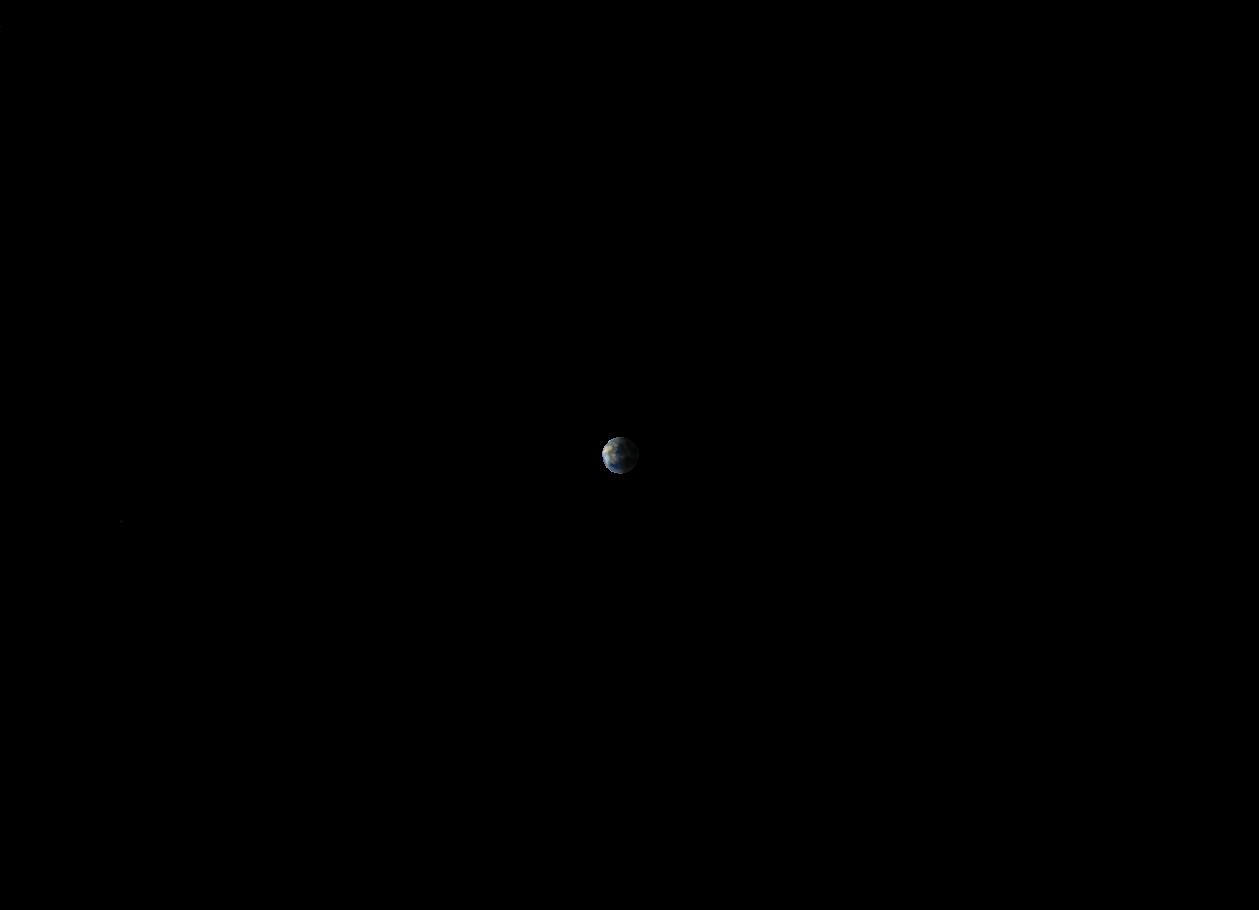
Nope. It's still doesn't show a wide enough range.
But if we zoom out even MORE, we can finally see where the Moon lives. Look over at the right-hand edge of the picture.
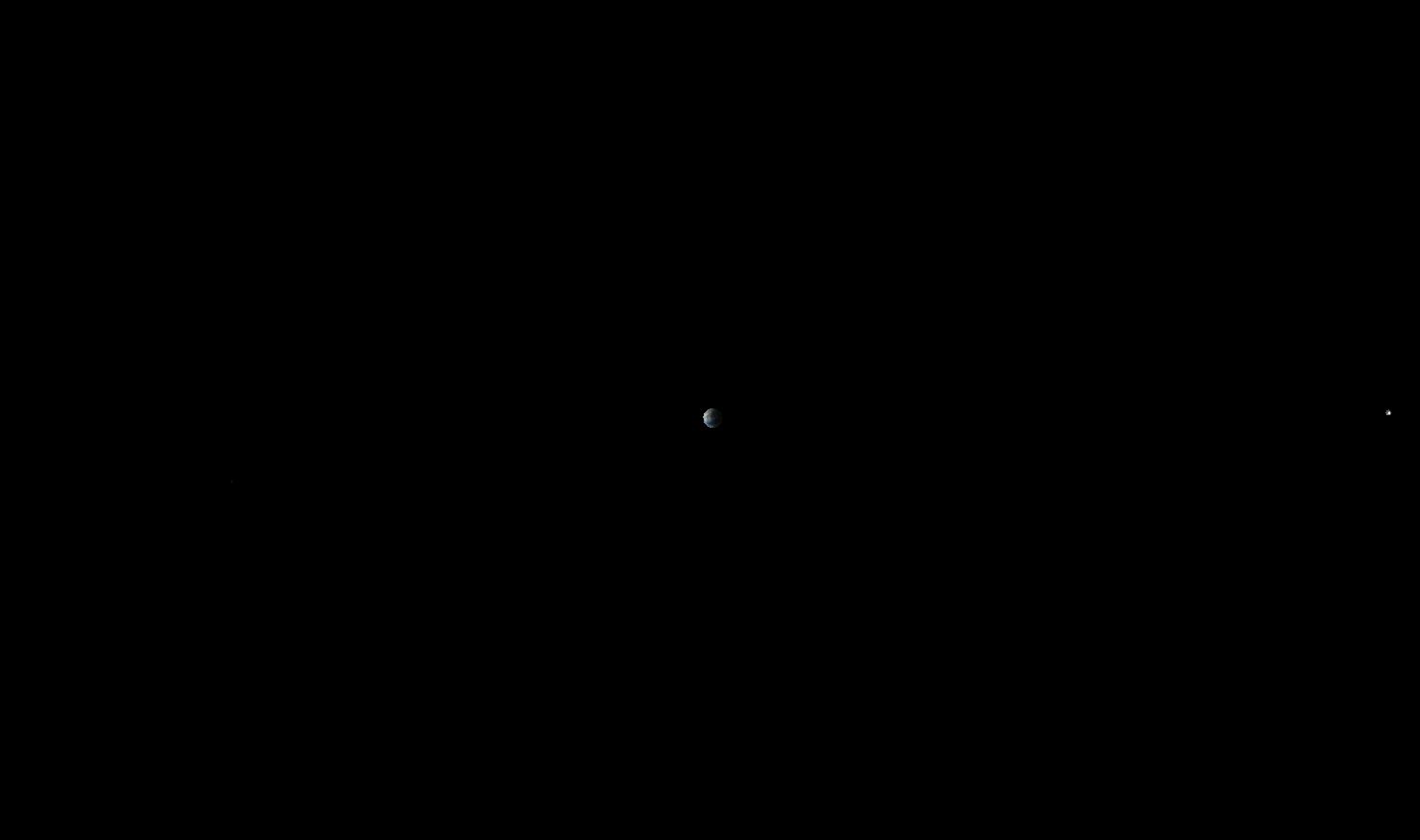
The Moon orbits the Earth at a distance of about 60 Earth radii. Since our little model of the Earth is about 0.13 meters in radius, that means we should place the little ball representing the Moon at a distance of about 7.8 meters from the globe. That's roughly the size of a typical classroom at RIT.
So, given our globe of the Earth, the Earth-Moon system would just barely fit inside a classroom.
But we're just getting started!
You may have heard that the planet Mars will soon come especially close to the Earth. It's true: although Earth catches up to Mars and passes it in its orbit once every 780 days or so, not all those passes are the same. The orbit of Mars has a rather high eccentricity -- it's not a perfect circle, but a rather squished ellipse. That means that it sometimes comes closer to the Sun (and the Earth), and sometimes runs farther away. In October, Mars will be relatively close to the Sun, and therefore the Earth.
That means that Mars will appear to grow larger than usual as seen through a telescope. The diagram below shows the appearance of Mars in its last opposition, in 2018; this year's passage will produce a similar growth in its apparent size.
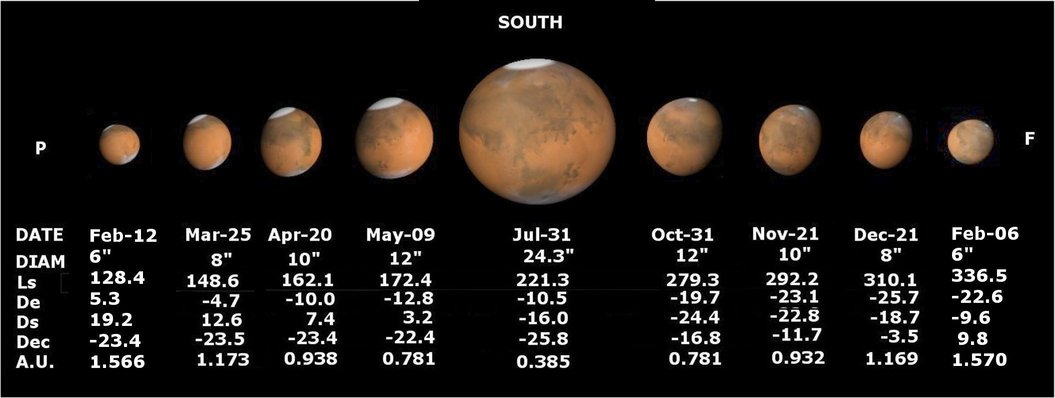
Image courtesy of
Association of Lunar and Planetary Observers
Let's continue to build a model of our Solar System, using the globe of the Earth as a starting point. Mars is somewhat smaller than the Earth, so I can represent it with a ball about 7 cm in radius.
Q: How far from the globe should I place the ball
in order to show the proper scale of the distance
between the Earth and Mars, during this close approach?
The correct answer is ... far, far away. At its closest approach, Mars comes within about 57.6 million km from the Earth, so using our scale model,
6 1 Earth radius 0.13 m
distance to ball = 57.6 x 10 km * --------------- * -------------
6378 km 1 Earth radius
= 1200 m = 1.2 km
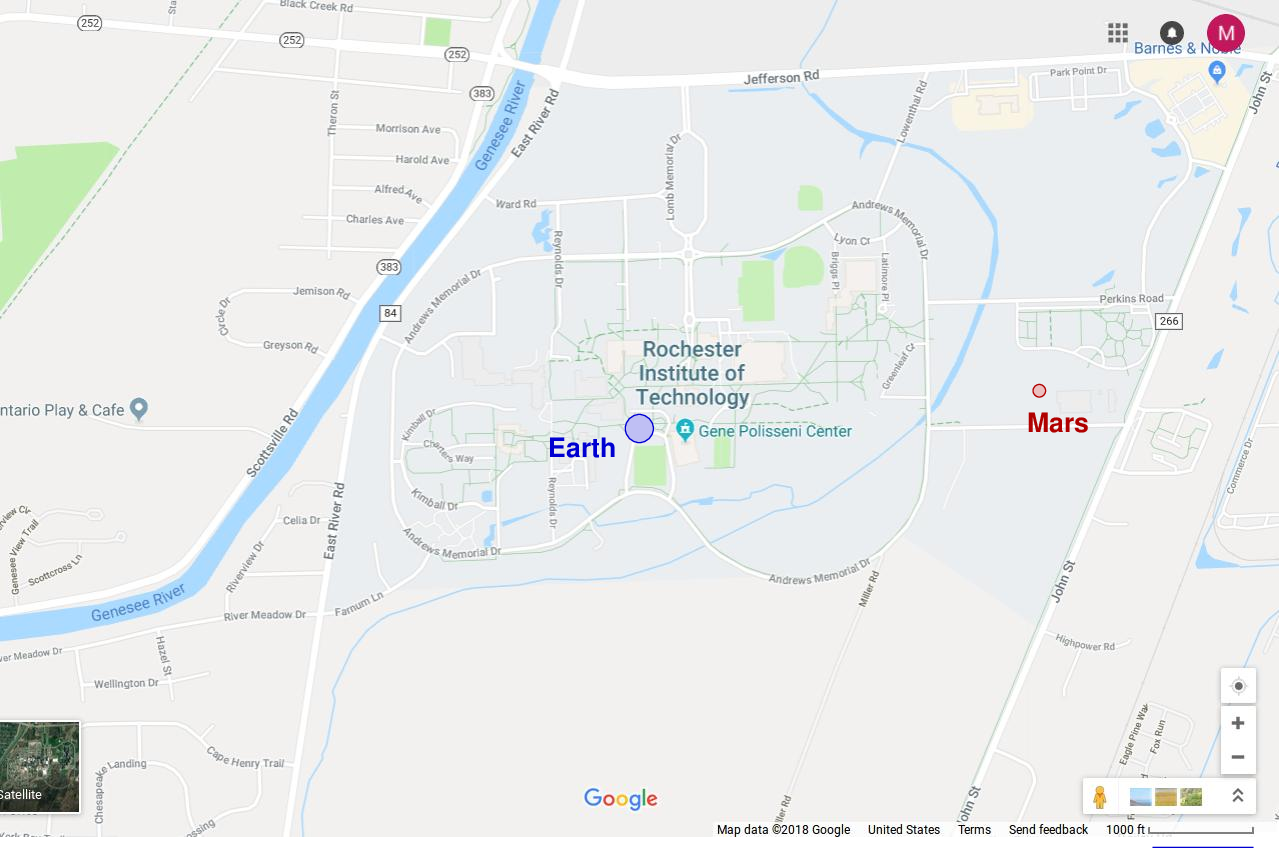
What about some other bodies in our solar system? The Sun, for instance. You know the Sun is much larger than the Earth, right? Relative to the globe, a big glowing sphere to represent the Sun would have to be about 14 meters in radius.
Q: How far from the globe should I place the giant
glowing 14-meter sphere in order to show the proper
scale of the distance between the Earth and the Sun?
The answer is ... near the Marketplace Mall.
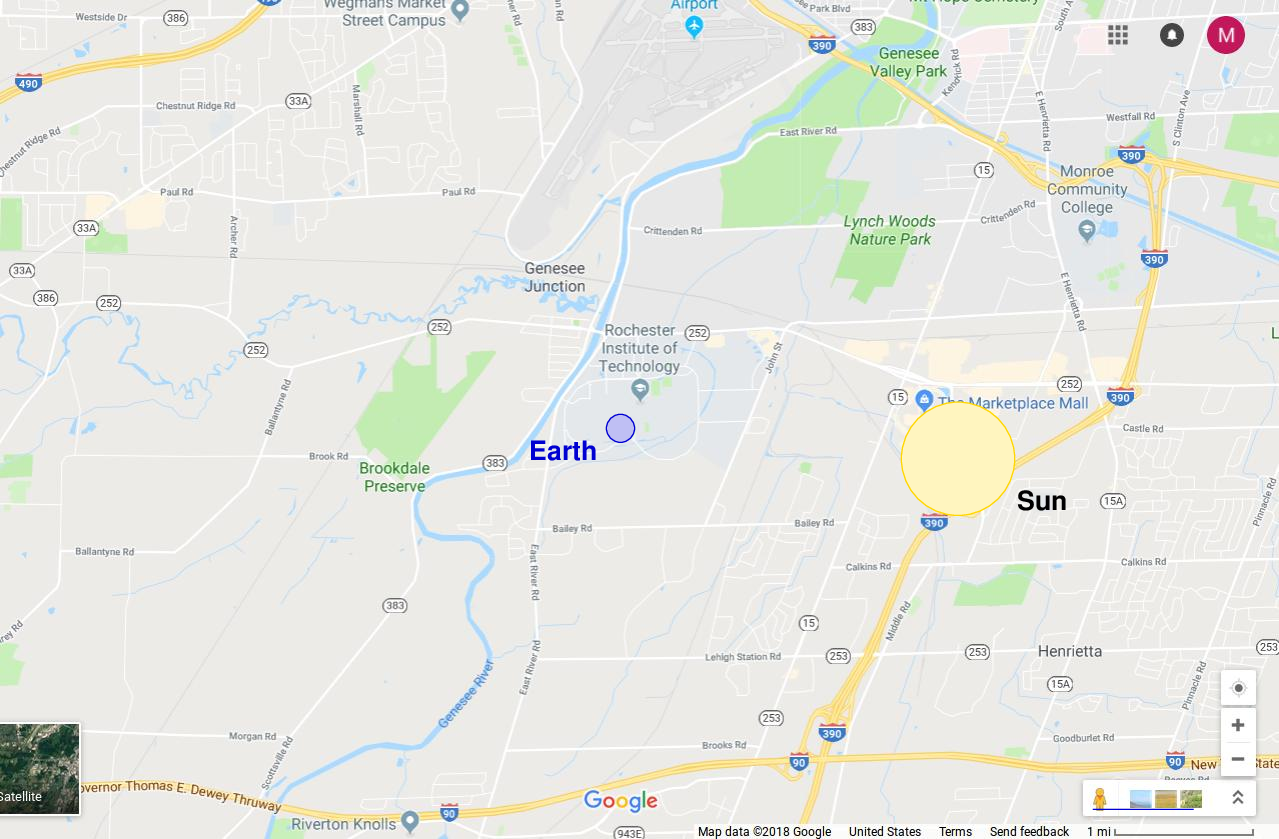
The relative sizes of the Earth and Sun aren't show to their proper
scale in this diagram; if they were, the Earth would be too small
to notice.
Now, in real life, the Earth-Sun distance is about 149,600,000 kilometers, or 149,600,000,000 meters. That's a lot of digits to write, and read, and remember. It's pretty clear that neither the meter nor the kilometer is a good choice for a unit to describe the distances between objects in our solar system. So, many years ago, astronomers created a unit which is designed specifically for this purpose:
The Astronomical Unit (AU) is defined as the semi-major axis
of the Earth's orbit around the Sun; in other words, roughly the
average distance between Earth and Sun.
1 AU = approx 149.6 million km
If you want to know the exact value, take a look at a table of constants from JPL's Horizons ephemeris system.
Using this special unit, we can describe distances using numbers that range between 0.1 and 100 -- easy to read, and write, and say.
Mars' closest approach in 2018 0.39 AU
Earth-Sun distance 1.00 AU
See? Easy-peasy.
But the solar system extends far beyond Mars, of course. Consider the icy-cold world we call Pluto:
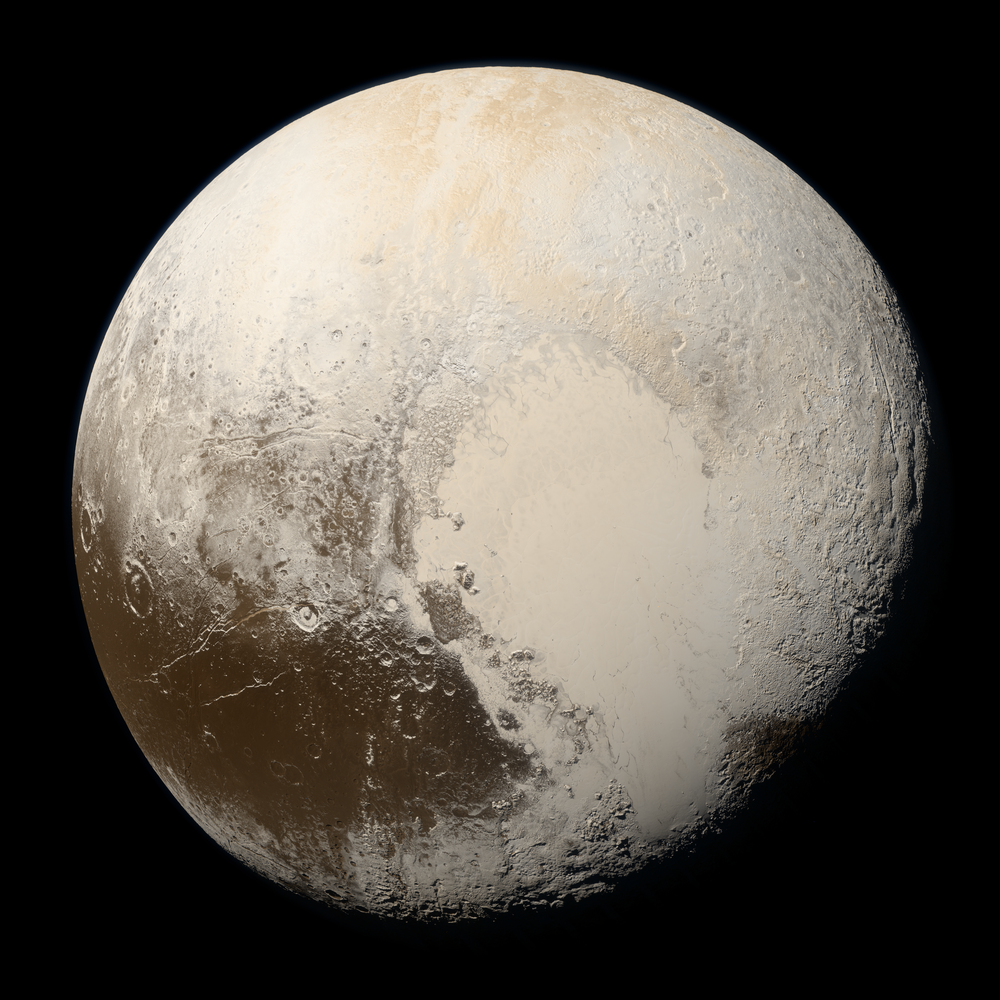
Image of Pluto courtesy of
NASA/Johns Hopkins University Applied Physics Laboratory/Southwest Research Institute/Alex Parker
Let's continue to use our little globe as a scale model of the Earth. On this scale, Pluto would be a little sphere about 2.4 cm in radius, just a bit bigger than a ping-pong ball.
Q: How far from the globe should I place a little
ball in order to show the proper scale of the distance
between the Earth and Pluto?
(If you have a calculator, and you want to do a bit of work,
the real distance is about 5.98 billion km)
Where on the map below should we place Pluto?

Nope -- it won't fit on that map!
Pluto orbits the Sun at about 5.98 billion km = approx 40 AU, which means that in our model, the little ball sits out in Syracuse.
9 1 Earth radius 0.13 m
distance to Pluto = 5.98 x 10 km * --------------- * -------------
ball 6378 km 1 Earth radius
= 122,000 m = 122 km
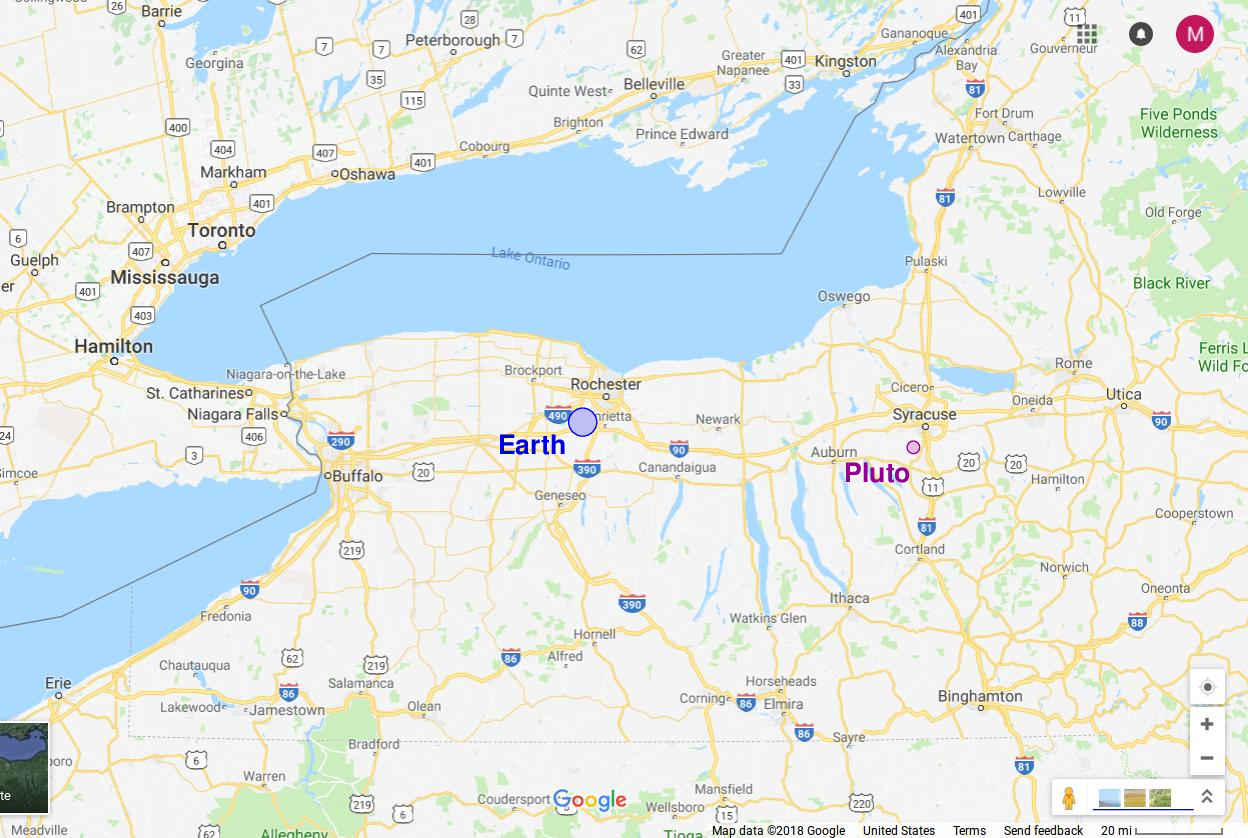
I hope you are starting to appreciate the enormous size of space.
But -- hey! So far, we've only considered objects in our own solar system, orbiting our own Sun. There are lot of other stars out there, too. We won't talk much about them in this course. But let's make a brief detour, just for a few minutes.
The Alpha Centauri star system, which contains three stars, is the closest to our Sun. We'll talk more about this system when we discuss the planet circling one of its components, Proxima Centauri b, later in the course.
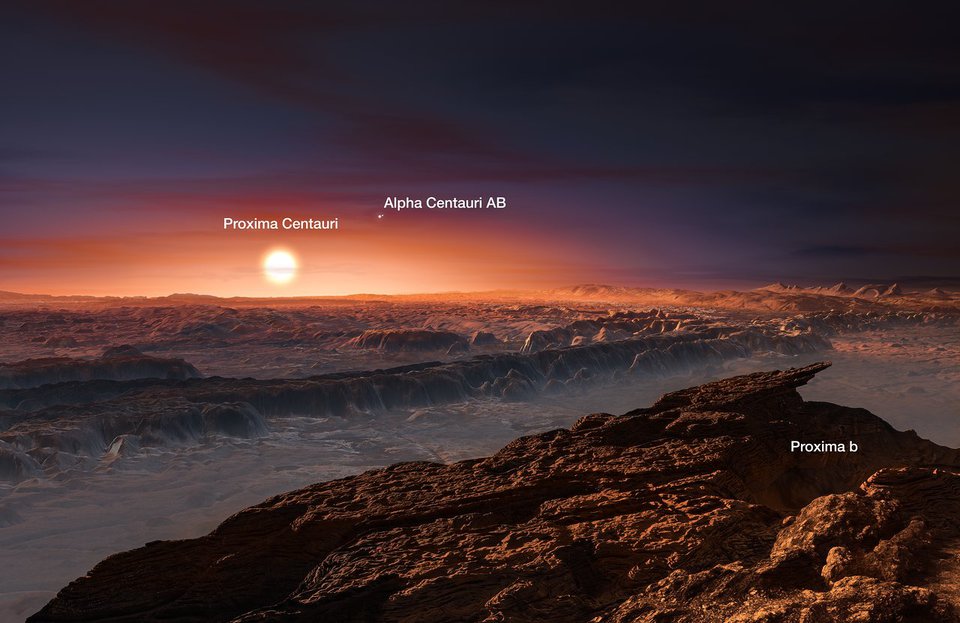
Image credit:
ESO/M. Kornmesser
How far is this CLOSEST star system from the Earth? Let's continue to use our globe to set the scale.
Q: How far from the globe should I place a 14-meter
sphere in order to show the proper scale of the distance
between the Earth and Alpha Centauri A?
Where should I place the marker for Alpha Centauri
on the map below?

Nope, it won't fit -- that map is too small. Let's zoom out.
How about this map?

Still too small. We need to zoom out again.

Rats. STILL too small to show the distance to the nearest star.
What if we zoom out again? Oh, hey, there's the Moon over near the right-hand edge of the picture.

Nope. We need to go out beyond the orbit of our real Moon -- a distance of over 500,000 km -- in order to place a marker for Alpha Centauri at its proper relative distance from our little, 13-cm globe.
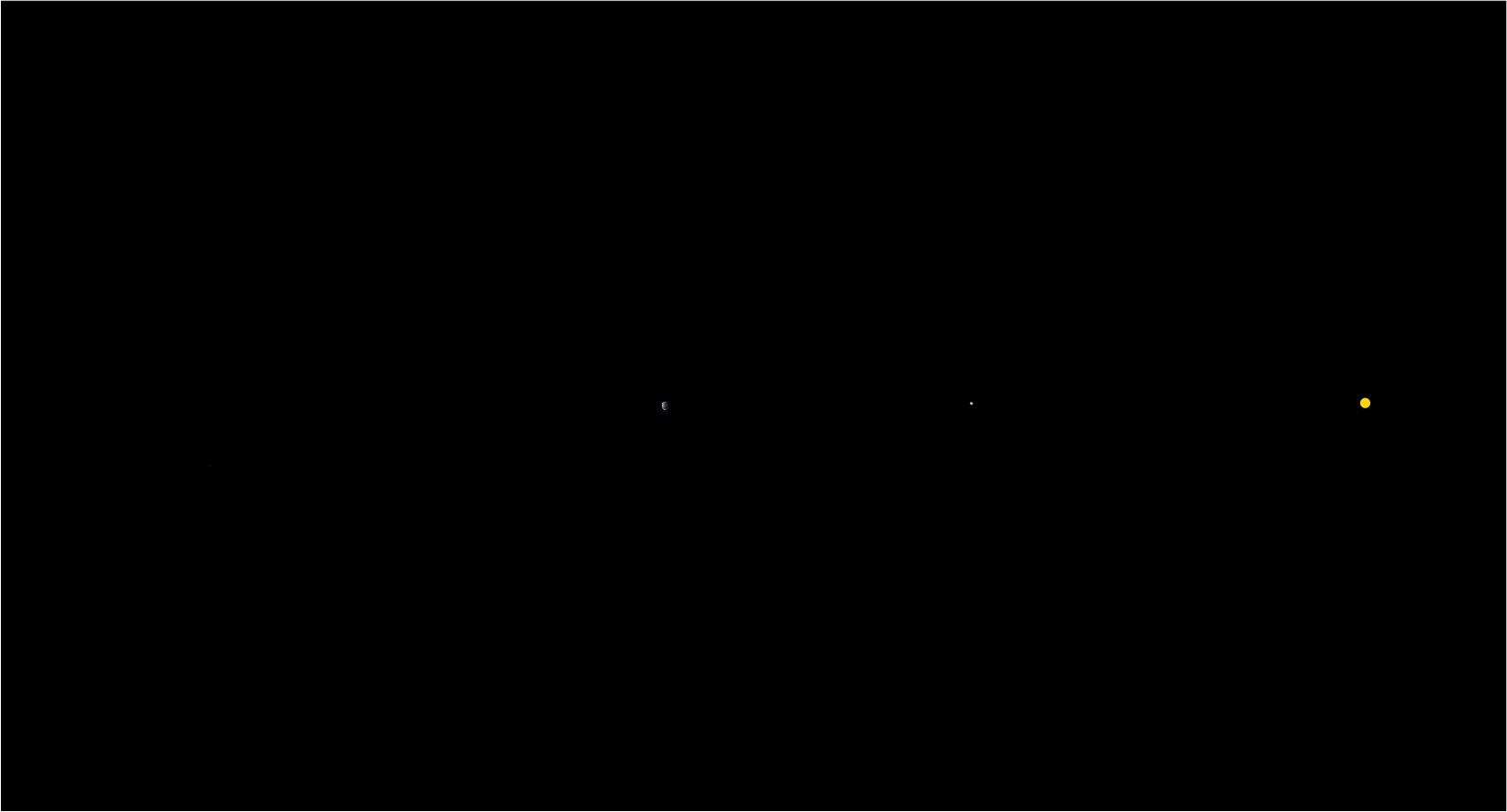
On this scale, the nearest star system would be more than twice as far away as the Moon! The real distance to this star is so large that plain old meters or kilometers just won't cut it:
Distance to Alpha Centauri system = 41,300,000,000,000,000 meters
41,300,000,000,000 kilometers
Even using Astronomical Units doesn't help all that much:
1 AU
Distance to Alpha Centauri = 41,300,000,000,000 km * -----------------
149,000,000 km
= 276,000 AU
We need a new unit to make inter-stellar distances easy to read and write. Astronomers have devised two, and you may see these occasionally during this course.
The light year (ly) is the distance light travels in one year.
1 ly = approx 9,443,000,000,000,000 meters
The parsec (pc) is the distance at which a distance of 1 AU
subtends an angle of 1 arcsecond.
Read this for an explanation
1 pc = approx 30,860,000,000,000,000 meters
If we use these units, then the distance to Alpha Centauri is nice and easy to write:
1 ly
Distance to Alpha Centauri = 41,300,000,000,000 km * ---------------------
9,443,000,000,000 km
= 4.4 ly
Q: What is the distance to Alpha Centauri in parsecs?
 Copyright © Michael Richmond.
This work is licensed under a Creative Commons License.
Copyright © Michael Richmond.
This work is licensed under a Creative Commons License.